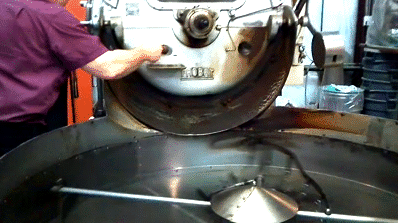Navigation article:
Coffee Roast Guide
Roasting is really a heat procedure that turns coffee in to the aromatic, brownish beans we all know and love.
Why roast?
 Roasting brings about the aroma and flavor that’s locked within the eco-friendly espresso beans. Beans are stored eco-friendly, a condition that they could be stored without lack of quality or taste. A eco-friendly bean has no characteristics of the roasted bean — it’s soft and spongy towards the bite and smells grassy.
Roasting brings about the aroma and flavor that’s locked within the eco-friendly espresso beans. Beans are stored eco-friendly, a condition that they could be stored without lack of quality or taste. A eco-friendly bean has no characteristics of the roasted bean — it’s soft and spongy towards the bite and smells grassy.
Roasting causes chemical changes to occur because the beans are quickly introduced to high temperatures. Once they achieve the height of perfection, they’re rapidly cooled to prevent the procedure. Roasted beans smell of coffee, and weigh less since the moisture continues to be roasted out. They’re crunchy towards the bite, prepared to be ground and made.
Once roasted, however, they must be utilized as rapidly as you possibly can prior to the fresh roast flavor starts to diminish.
Roasting is both a skill along with a science
It requires many years of training to get a specialist roaster having the ability to “read” the beans making decisions with split-second timing. The main difference between perfectly roasted coffee along with a destroyed batch could be a few seconds.
Know your roasts
Most roasters have specialized names for his or her favored roasts and there’s hardly any industry standardization. This could cause some confusion whenever you’re buying, however in general, roasts fall under certainly one of four color groups — light, medium, medium-dark and dark.
Many consumers think that the strong, wealthy flavor of more dark roasts signifies a greater degree of caffeine, however that light roasts really possess a slightly greater concentration.
The right roast is really a personal choice that’s sometimes affected by national preference or geographic location. Inside the four color groups, you’ll probably find common roasts as the following. It’s smart to ask before you purchase. There might be an enormous amount of distinction between roasts.
Light roasts
Light brown colored, this roast is usually preferred for milder coffee varieties. There won’t be any oil at first glance of those beans since they’re not roasted lengthy enough for that oils to interrupt right through to the top.
- Light City
- Half City
- Cinnamon
Medium roasts
This roast is medium brown colored having a more powerful flavor along with a non-oily surface. It’s frequently known as the American roast since it is generally preferred within the U . s . States.
- City
- American
- Breakfast
Medium dark roasts
Wealthy, dark color, this roast has some oil at first glance with a small bittersweet aftertaste.
- Full City
Dark roasts
This roast produces shiny black beans by having an oily surface along with a pronounced bitterness. The more dark the roast, the less acidity is going to be based in the coffee beverage. Dark roast coffees run from slightly dark to charred, and also the names are frequently used interchangeably — make sure to look at your beans before you purchase them!
- High
- Continental
- New Orleans
- European
- Espresso
- Viennese
- Italian
- French
Image credit: William M. Murray, Giphy
Resourse: http://ncausa.org/About-Coffee/
